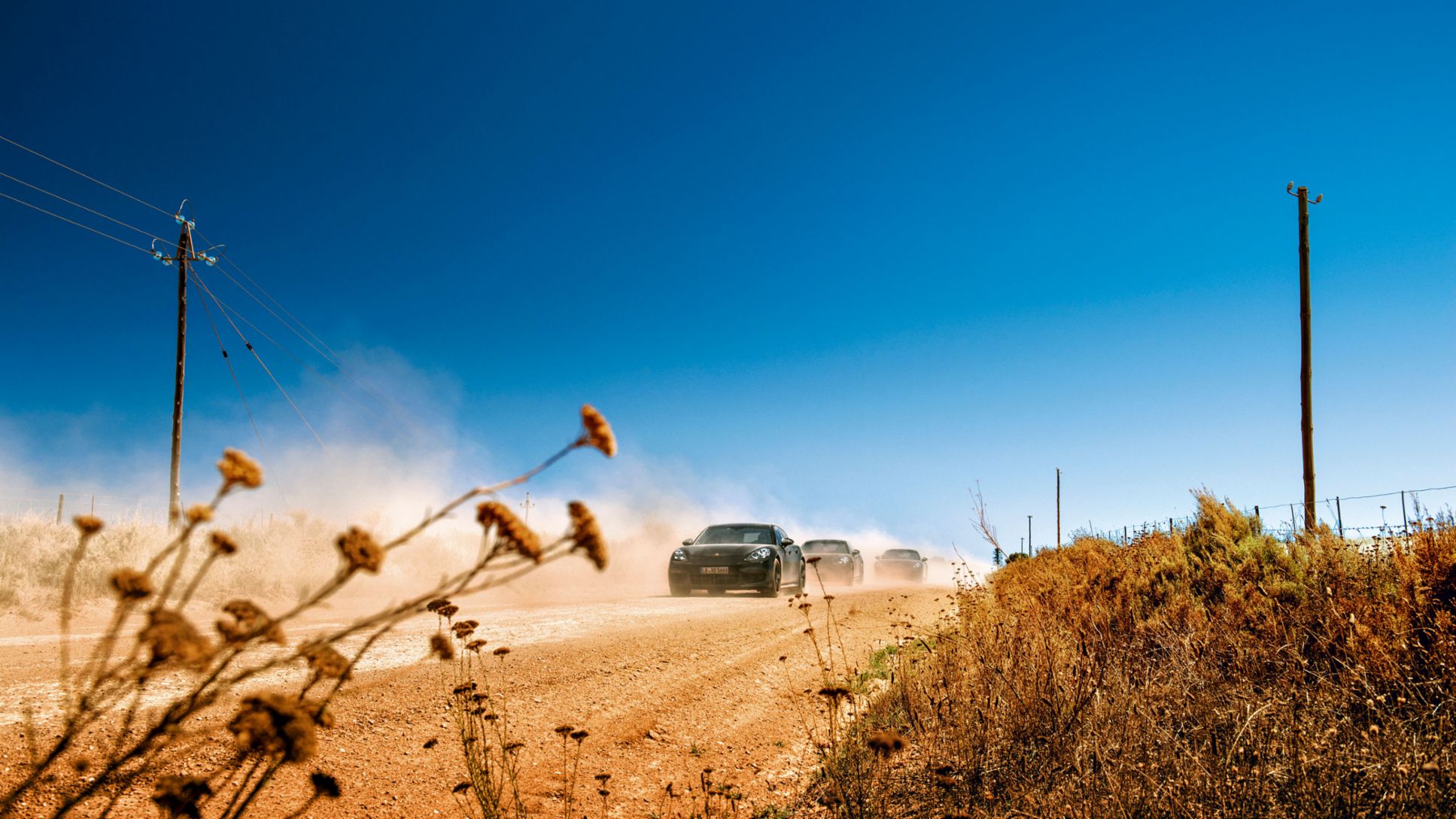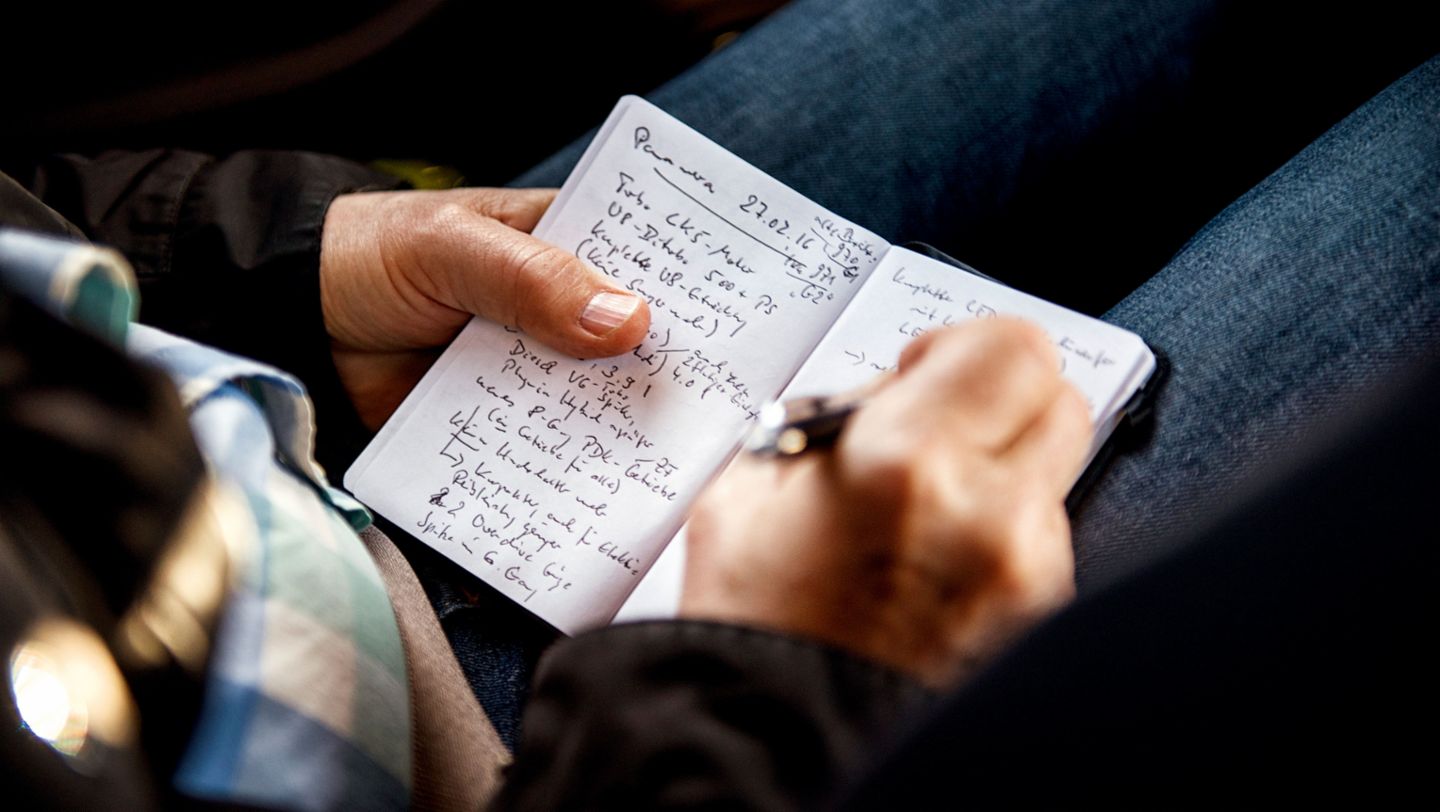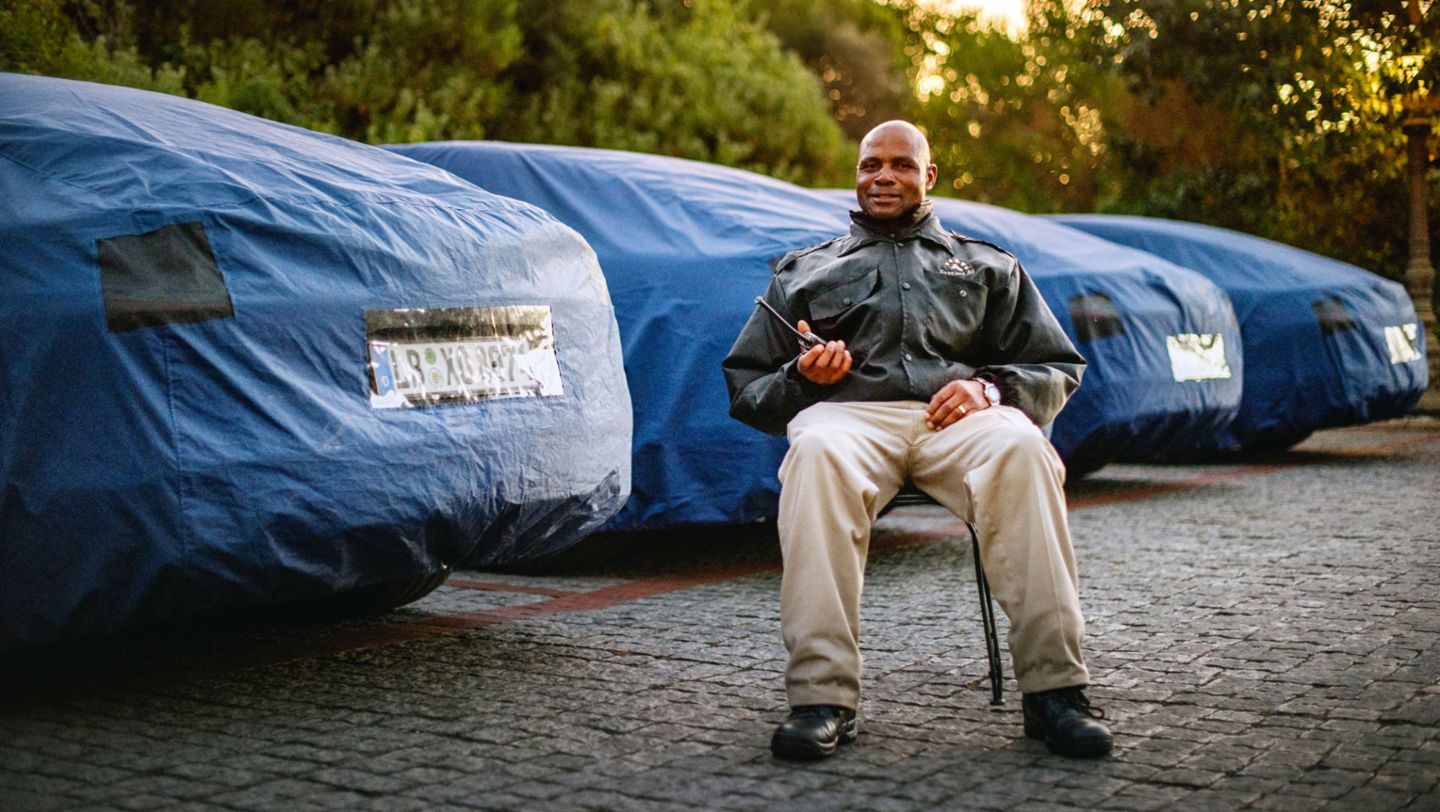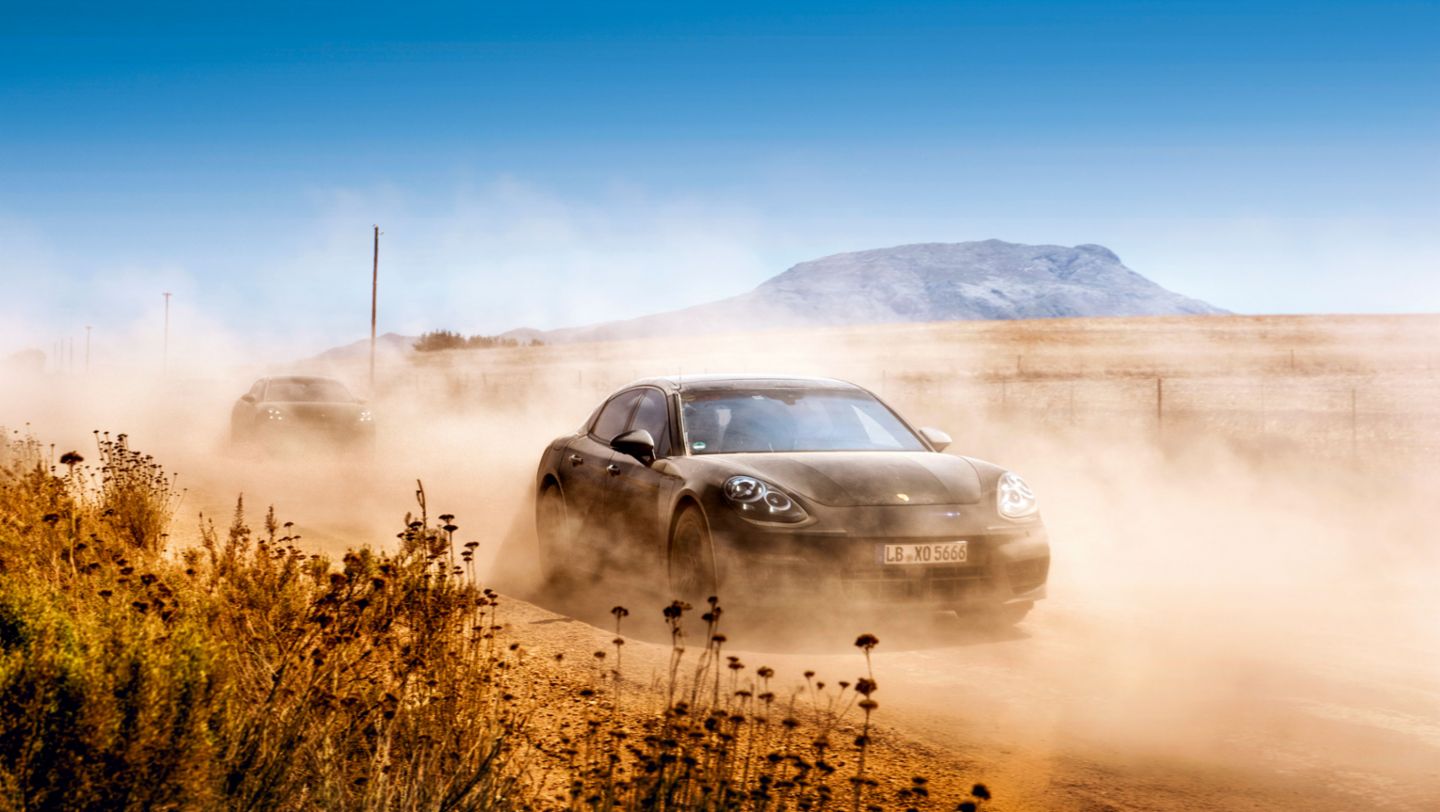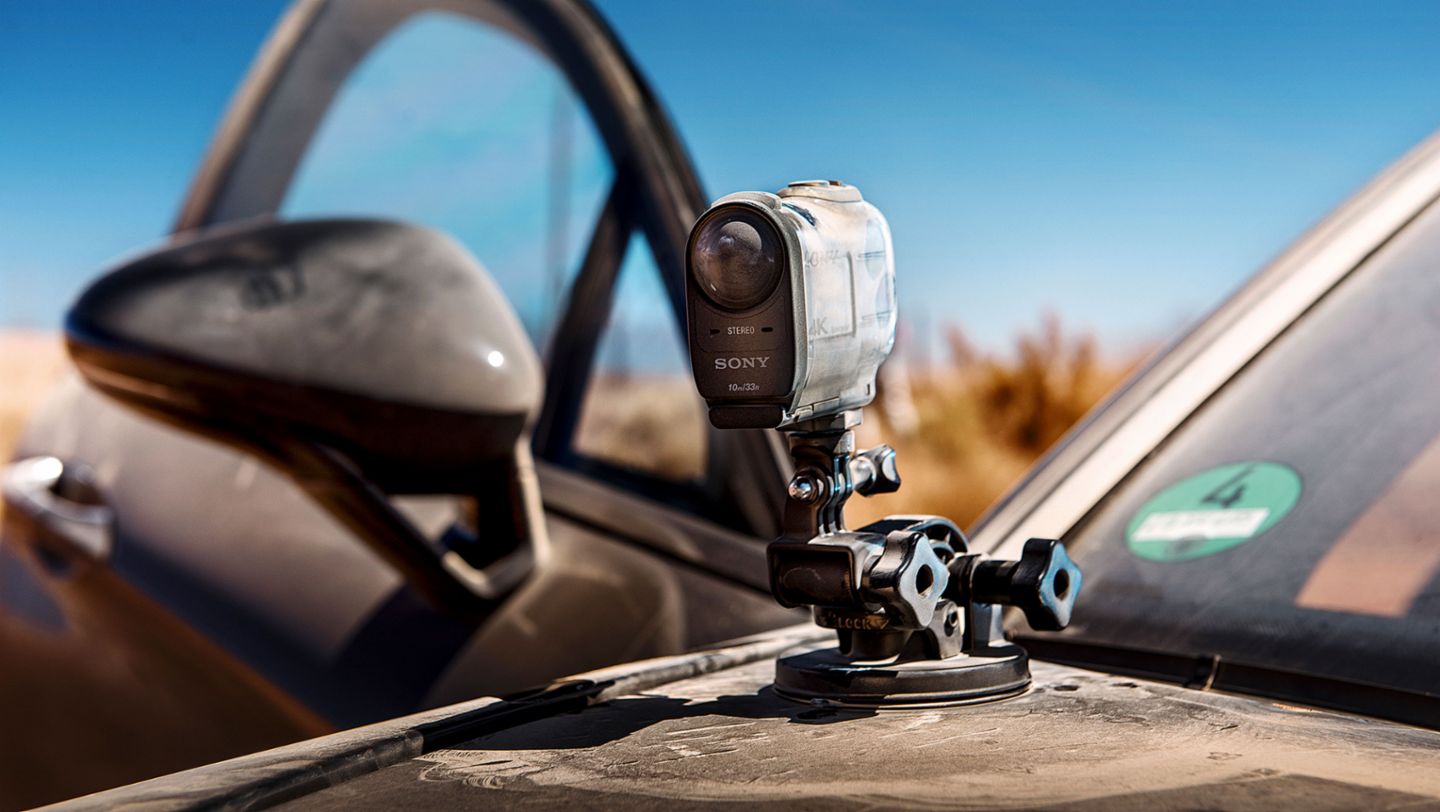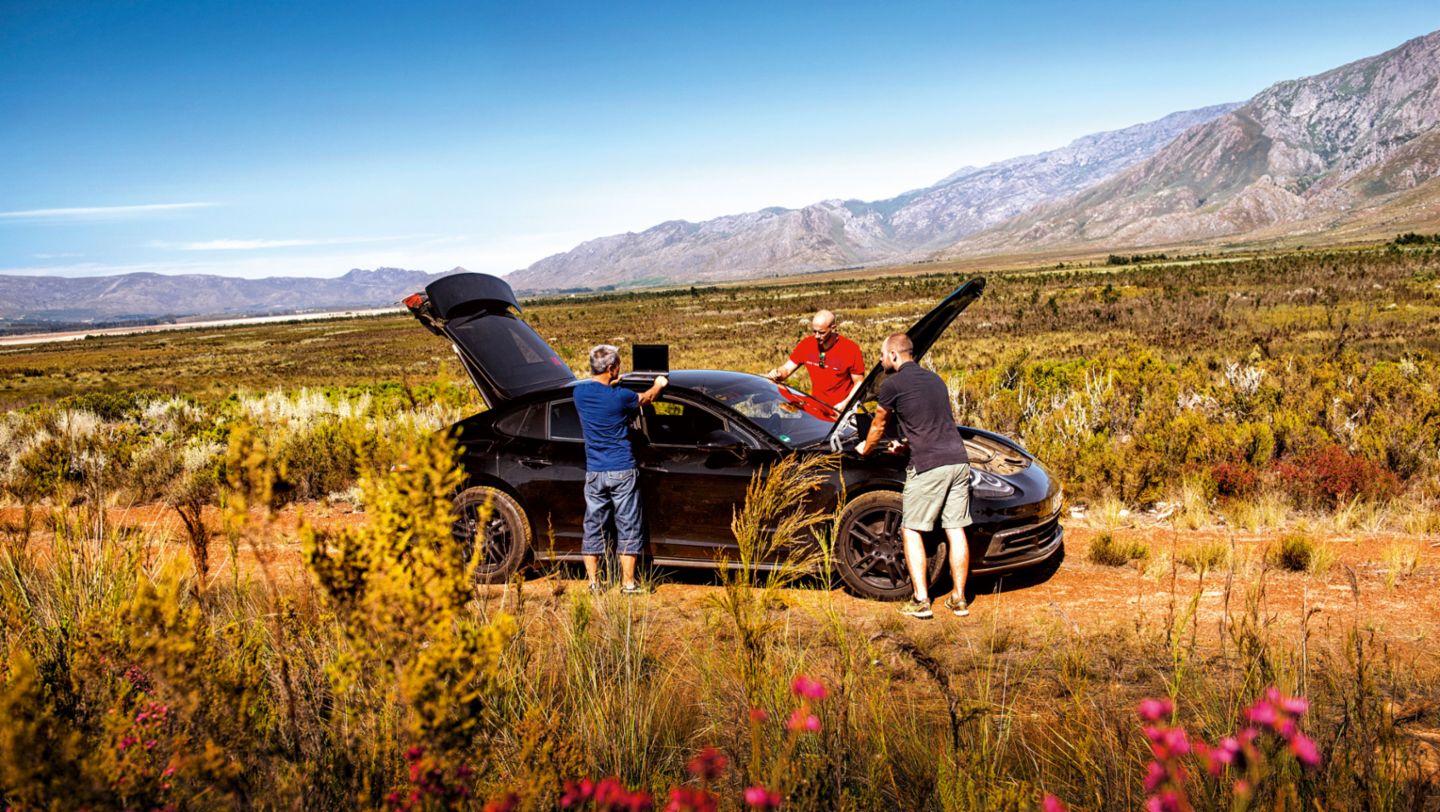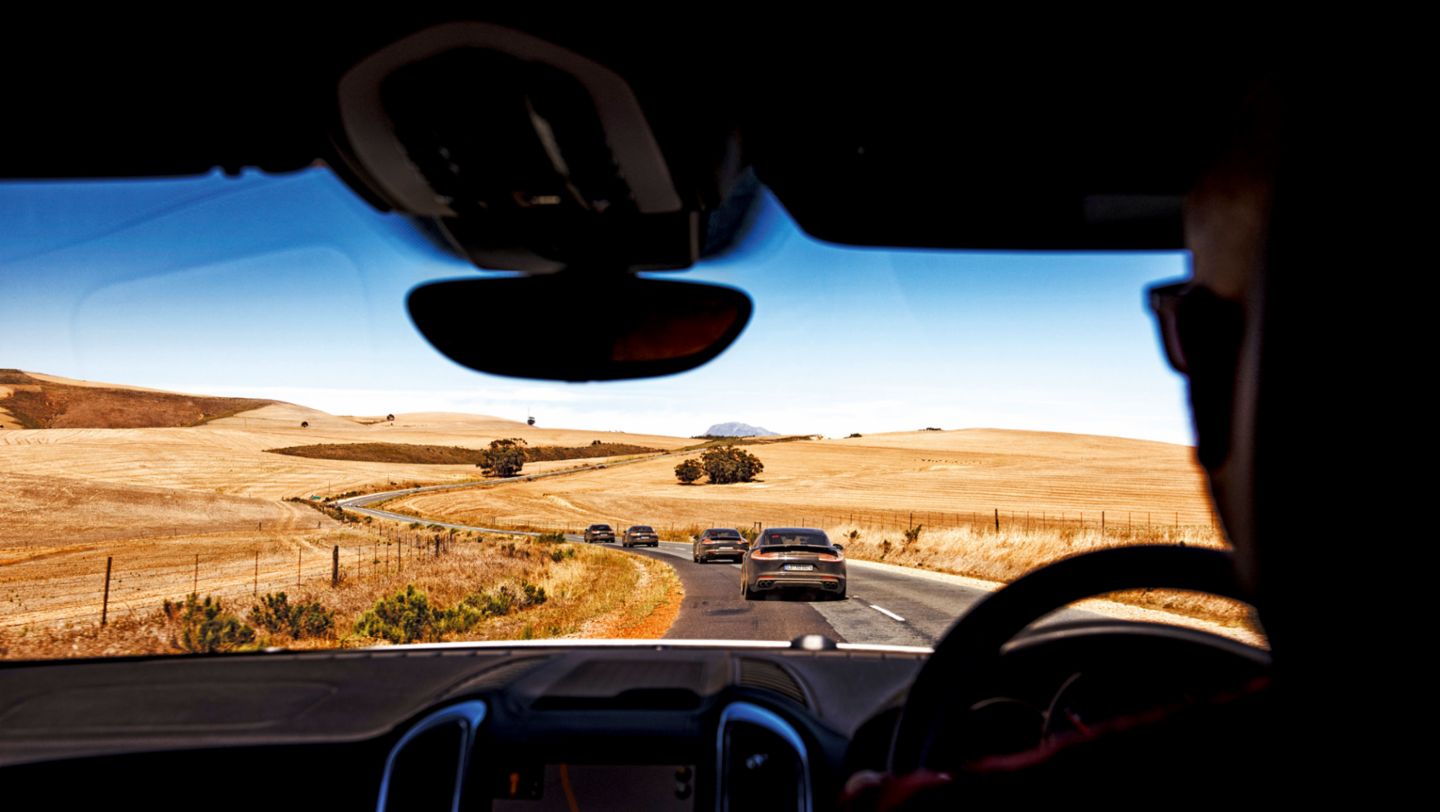7:04 a.m.
Early March. Cape Town. The tactile qualities of the push button on the center console don’t seem quite right. And the transition between second and third gear is clearly still too stiff. The Porsche engineers are in the midst of a series of test-drives for the Panamera. They’ve completed all of the preparations for today’s trials. The last briefing before the engines start up is like the calm before a storm. Another moment of focus, a narrowing of attention – all in the search of subtle adjustments to give the sports sedan that final touch of perfection.
9:53 a.m.
Franschhoek. A delightful wine-producing region not far from Cape Town, at the foot of the Drakenstein Mountains. Driving up the winding road to the pass, the Panamera accelerates out of a curve to the orchestral acoustics of its new V8 bi-turbo engine. Four thousand cc of displacement generate not only a sound befitting its commanding presence, but also a boundless desire to perform. The lightly camouflaged black car maneuvers effortlessly through the slalom of curves toward the peak, powering at more than 4,000 rpm without a pause for breath. Then the driver pulls a fast one; to be precise, he slams on the ultramodern ceramic brakes. Just seconds later, we hear the relaxed bass tones of the eight-cylinder engine in repose – the very picture of calm. Test passed.
The test crew is ready for everything
Dr. Gernot Döllner, the director of the Panamera model line, steps on the gas and drives the big Porsche up through the ascending course of curves. The display on the dashboard shows the Porsche Active Suspension Management (PASM) system in Sport mode. Every turn of the wheel is a breathtaking experience. “In principle, the new Panamera weighs about 176 pounds less than its predecessor,” he notes. But numerous additional features bring the total weight back up to the previous amount. In other words, the car offers more comfort, sportiness, and safety at no additional weight. The fact that the newcomer will be more dynamic than its predecessor in all respects is due largely to some fine adjustments as well as to a substantial boost in output. “We get a little better every day,” says Döllner. As an engineer, that is his job. Together with the Simultaneous Engineering team, he is responsible for the entire Panamera line. And when these trials are over, the new Panamera will head for the showrooms.
But at the moment, the convoy of black cars is awaiting the next stage of its series of arduous tasks. Covered in dust, in addition to the foil that serves as a partial disguise, the Porsche sedans exude an impressive air of assurance. Not long after a tough stint of trials in the icy cold of the polar winter, they now have the sun beating down on them from a shimmering blue sky. The test crew is ready for everything, from bone-chilling cold to blood-boiling heat. The pros are well aware that nature runs the gamut. They also know that the days of tests are often followed by nights of problem-solving. It continues until hundreds of thousands of test miles have been clocked – until every load alteration is a joy, and every switch functions precisely. The desire to dot the last “i” on the sportiest sedan in the luxury segment demands everything – and is its own motivation.
10:47 a.m.
Hermanus. This coastal town in the province of Western Cape is one of the best places in South Africa for winter whale-watching. While the first vacationers head out for a cliff walk, the Porsche team breakfasts on muesli and fried eggs.
At the stop in Hermanus, the cars are fueled and the next part of the route is discussed in painstaking detail. Test director Christian Kunkel ensures that the radio system is in flawless order and that the measuring gauges and data logs in the trunks are all ready for action. Then the engines start up again. For the past two weeks, every day has followed the same routine. Today’s agenda calls for 375 miles on country roads. South African roads can have extremely different conditions in quick succession. Rough asphalt with frequent, sudden drops due to washouts. Curves with tight radiuses. Climatic conditions spanning the Atlantic and Indian oceans.
The key concept here is lightweight construction
Mountain passes at altitudes of nearly two miles, rock-hard gravel roads through blazing stretches of desert – all with the ever-present hazard of roaming animals. For the engineers, South Africa poses challenges that can be simulated on test benches in Weissach but ultimately only mastered with complete certainty in practice. “Driving is the only way to determine that all of the components work together perfectly,” says Dr. Oliver Seifert, distilling the comprehensive task of the South African crew into a single sentence. Seifert is responsible for the complex development field of electrical and electronic engineering.
This area is subject to ever-shorter development cycles – and a rapidly expanding range of applications. The new adaptive cruise control (ACC) system alone communicates with thirteen control units. In terms of materials, the Panamera’s share of aluminum components also reflects the premium placed on future viability. The key concept here is lightweight construction. The car’s floor structure and transmission tunnel are made entirely of aluminum, as is the body itself. High-strength steel alloys in the A and B pillars ensure torsional stability and protect the driver and passengers.
The exterior dimensions of the sports sedan have hardly changed from those of its predecessor, but the new car body seems lower, thanks to artful work by the design department. The upper edge of the windshield takes about 0.39 inches off the top, whereas the flyline extends more than 0.79 inches deeper at the rear. The C pillars also extend farther toward the back. This coupe-like impression gives the new Panamera a sportier appearance. The outside has the same dimensions, but the inside has more room – another advantage of the additional 1.18 inches in the wheelbase. The result: even more knee room as well as greater volume in the trunk – now at 18 cubic feet. “Which means more space for all of our test equipment,” one of the drivers notes drily.
1:22 p.m.
The Little Karoo, a semi-desert plateau and one of the most scenic destinations in South Africa. The Panamera rolls along on 21-inch wheels whose tracks have been narrowed by 0.39 inches for yet another visual contribution to an elegant silhouette. Completely redeveloped engines provide the flagship with more than 500 hp (combined fuel consumption*: 9,4-9,3 l/100 km; combined CO2-emission*: 214-212 g/km), dosed by the eight-speed PDK (Porsche double-clutch transmission). Its lower frictional resistance significantly reduces average fuel consumption. The seventh and eighth gears have longer ratios, which also lowers consumption. The Panamera Turbo, with a supercharged V8 engine, reaches peak speed in sixth gear. The goal was to make power available if drivers want greater driving dynamics while also saving fuel under normal traffic conditions.
While Döllner is still extolling the precision of the new electric steering system, Kunkel comes on the radio: “Driver swap! Ten-minute break for an update.” The engineers pull into a parking bay and spread black neoprene covers over the dashboards, consoles, and door panels. The new interior is still top secret and has to be protected from the potential gaze of paparazzi. Kunkel takes Döllner aside to discuss a hitch in the electrical steering system noted a few minutes earlier: a drop in support when the engine is idling after having been warmed up. Seifert adds his expertise to the exchange and suggests that the cause lies in different software updates for the relevant components. After another quick software update, the problem is gone. Kunkel gives the order to start up again. The afternoon break is coming up, but not for another 149 miles.
The Panamera is tough
Following its run through the mountains, the Panamera now glides nearly soundlessly through the red-brown landscape at 75 mph. This moderate driving style is a product of InnoDrive – the latest generation of the ACC system. A semi-autonomous system with active acceleration and braking, it improves fuel economy by as much as 10 percent in the New European Driving Cycle (NEDC). As to why we don’t hear the engine, that is explained by a look at the center console – the rev counter is only at 1,400 rpm.
In fact, when the driver steps off the gas, the engine starts idling. The Panamera can now essentially “sail,” as the engineers say. Even then the rev counter’s scale goes to only 5,000 rpm, which means that the new V8 diesel engine is running on a 4,000-cc displacement. In this partial-load range, the acoustics completely fade into the background. But it doesn’t have to stay that way. Just switch into Sport Plus mode by turning the thumbwheel on the steering wheel. In a flash, the transmission shifts into the right speed for maximum torque. The throttle response heightens and the car shoots forward. But even for this mode, the Panamera 4S Diesel needs hardly more than 2,000 rpm. Its sound becomes a little hoarser, but it barely raises its voice. A dry clack accompanies the precise and comparatively early gearshifts as the needle rises smoothly on the speedometer – 160, 170, 190 – the thrust continues, quickening both the car and the heart.
4:08 p.m.
Afternoon break. The crew uses their rest to discuss the results. Are they satisfied thus far? Everyone smiles. The benefits of a two-week series of test-drives can hardly be exaggerated – it’s invaluable to be out on the road with so many expert colleagues at once. The shared driving experience is extremely productive in everyone’s eyes. While components can be developed in isolation, their interplay is perfected in just such situations. Many things can be accomplished more quickly out here. Sometimes the change in surroundings can help in addressing questions and analyzing problems with an open mind. “To find the truth, hit the road” is a simple but accurate saying among developers. More complex issues are delegated to the developers in Weissach to work on during the night, and their recommendations often arrive by the next day. The engineers speak from the heart when they note that “proposals on paper back at the office will produce more disagreements than the unambiguous results of a test-drive.”
The report from Weissach says that work is already underway on producing a more pleasant tactile response from the switch on the center console, which the boss had criticized that morning. Here in South Africa, the engineers continue to drive their fleet along dusty roads littered with rocks. Enormous potholes plague the pneumatic suspensions and low-profile tires. Sharp impacts resound again and again on the underbody. No one casts a glance at the rugged landscape; all eyes are focused on the road ahead. The denser the dust, the rarer the communication among the test cars. When the road becomes paved again, a short break is taken to remove the dust from the inner wheel rims and brake discs. Kunkel hands out bottles of water. Someone brushes the dust from his clothes. “Hardly any of our customers will be driving on roads like this,” says Kunkel. “Still, the roads are good for sounding out any potential weaknesses in the materials.”
6:29 p.m.
Riversdale, a small town in the farming region between Cape Town and George. The convoy is now heading for its quarters, anticipation seeming to heighten the pace. Official authorization has been secured for the test cars to drive at speeds above the legal limit. The authorization allows higher speeds for test purposes, but requires responsible behavior. Only about 150 miles separate the drivers from the very appealing prospect of a shower.
It is nearly nine in the evening when the dirt-covered fleet of Panameras reaches its underground garage. The engines can finally rest, and the cars cool down with a faint crackling sound. Opaque tarps then cover them from view. But anyone who expects the crew to sit down and relax has no idea what Porsche test-drives are like. After brief phone calls with their families back home, the team gathers to discuss the day’s anomalies. One member didn’t like the vibrational excitation displayed by a side panel on a critical segment before Franschhoek Pass; another would like to see a stronger retractor spring on the lid of a storage compartment. Records are kept of everyone’s observations. At last, it’s time for dinner. Only now, after long hours of concentration on the most complex issues in automotive engineering, does the Porsche test team finally wind down.
11:33 p.m.
The long day has come to an end after a dusty tour that required every driver to drink over a gallon of water. But Döllner will still go through the reports from his crew once more in peace and retrace the tour in his mind – constantly in search of the last little detail that might not be quite right.
Consumption data
Panamera 4S: Combined fuel consumption*: 8,2-8,1 l/100 km; Combined CO2-Emission*: 186-184 g/km
Panamera 4S Diesel: Combined fuel consumption*: 6,8-6,7 l/100 km; Combined CO2-Emission*: 178-176 g/km
Panamera Turbo: Combined fuel consumption*: 9,4-9,3 l/100 km; Combined CO2-Emission*: 214-212 g/km
Info
Text first published in the Porsche customer magazine Christophorus, No. 377
By Jürgen Zöllter // Photos by Tim Adler
